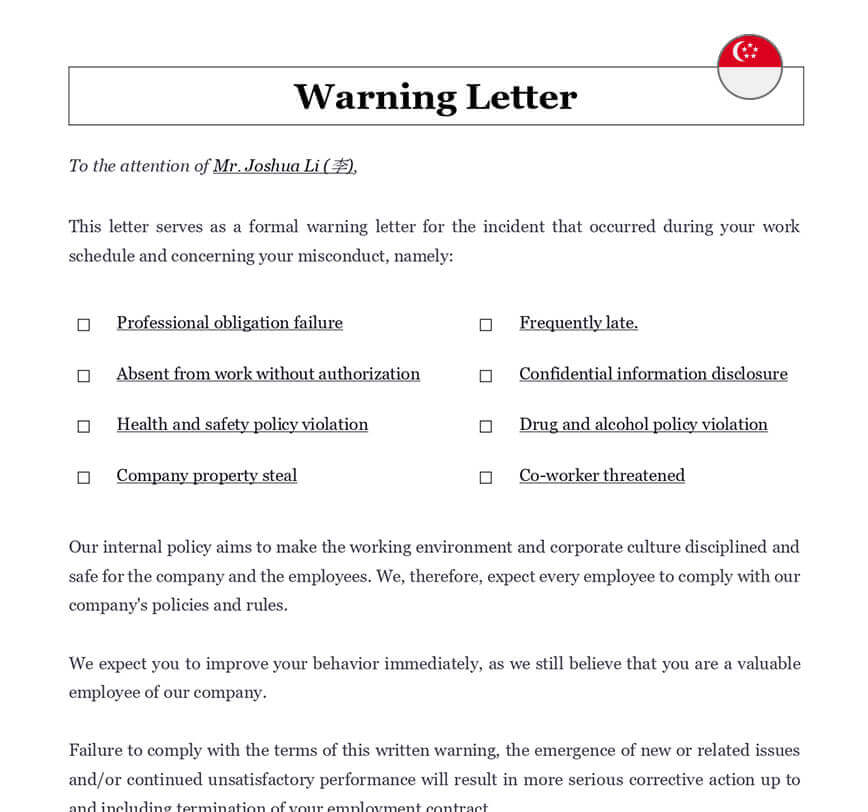What does a reprimand letter serve?
Employers, team leaders, and superior managers utilize letters of reprimand as disciplinary measures. A letter of reprimand, also known as a warning letter, effectively conveys to an employee that they need to change some part of their work conduct, such as employee performance, teamwork ethic, insubordination, and so on.
A written reprimand letter’s principal objective is to advise corrective action and to avoid (future) unacceptable behavior. It also tracks an individual’s attempt. When someone behaves badly, the reprimand is given in the form of a warning letter or a first penalty.
Some popular reasons for drafting this sort of letter include:
1. Being late: If someone in your department is frequently late, you might consider giving a formal warning.
2. Absence: Absence from work may result in missed tasks and disappointing performance. It may also have a negative influence on the person’s department or team, implying that immediate employee performance improvement is required.
3. Unsuitable behavior: An individual’s behavior has an impact on the overall culture and atmosphere of the company. If someone in your company misbehaves, it may have an effect on others. In this case, drafting a reprimand letter can aid in establishing progressive discipline, which will, in the long term, help prevent such events from occurring again.
4. Misuse of corporate equipment: If an employee is unsure how to operate corporate equipment after repeated training, a written employee reprimand is issued as an official warning.
5. Failure to adhere to a protocol: Each job has its own set of expectations. A written warning stresses the importance of following job-specific requirements.
6. Avoiding corporate meetings: Meetings are essential for employees to get important information about your company and should not be skipped. If an employee routinely skips meetings yet becomes defensive or begins rebuttals when questioned, you must intervene.
A official letter is written to the HR department informing them that this employee has violated the corporate code. The following actions are then decided upon by human resources. Typically, but not always, a reprimand letter containing the employee’s name and other information is filed in the employee personnel file.

How to write a letter of reprimand?
Warning/reprimand letters are important for conveying concerns and causing speedy adjustments among your team members. By writing your letter directly, you may send your message more efficiently.
Here are a few tips to ensure that your objectives are clear:
1. Informally address your problem
Before you begin writing a letter of reprimand, consider the purpose and significance of such an action. Unless an employee’s actions are really serious, a polite talk or casual email should take place prior to any official meeting.
When speaking with your employee, consider their track record to see if there have been similar events in the past that indicate chronic improper behavior or a persistent performance concern.
In most circumstances, postponing the issuing of a warning letter until after a second occurrence demonstrates respect for them while simultaneously communicating power by delaying disciplinary action. Even if you’re dealing with this issue informally, keeping a record of your conversations is a smart idea. The documentation creates a paper trail and assists in impartiality, both of which are necessary for taking future action.
2. Keep your letter's purpose in mind
You want your team to succeed as a manager. As a result, any feedback or advice you provide should be straightforward and simple for the person receiving it.
As a result, the initial lines of your message should be straightforward and professional, indicating the purpose of the letter.
Here are some techniques to ensure that your objective is clear:
| ➤ State that the letter is a reprimand letter |
| ➤ Include dates of any informal warnings or discussions you've had with the employee |
| ➤ Give the date of the adverse incident that occurred |











